2015-2016 Undergraduate Research Grant Recipients
Omar Aguilar
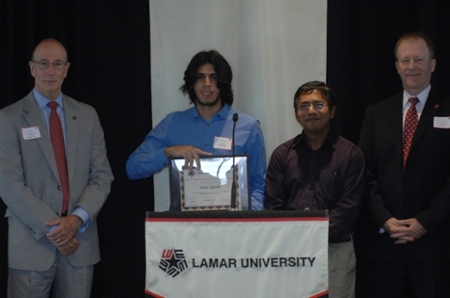
Mentor: Dr. Andrew Gomes
Research: Chromatograph-Mass Spectrometric Analysis of Phthalates in Food Packaging and Children's Toys
Abstract: Mucocutaneous leishmaniasis is debilitating human infectious disease that causes ulcers in both the skin and mucus layers and can lead to severe disfigurement of the mouth and nose. Leishmania has been successful as an infective agent partly due to its proteophosphoglycans on the surface (PPGs). Secreted PPGs are species and stage specific, and their significance in mucocutaneous forms of Leishmania have not been analyzed. The proposed study will examine the pattern of gene expression of PPGs in L. amazonensis. Real-time PCR experiments using RNA from lab-cultivated promastigotes (sandfly stage) and amastigotes (human stage) will be performed to identify the specific stage of expression. PPGs will be tagged with a reporter gene to visualize the formation of filamentous PPG during in vitro infection of human cells to establish the role of PPGs during infection and its potential as a vaccine candidate.
Stephanie Bermudez
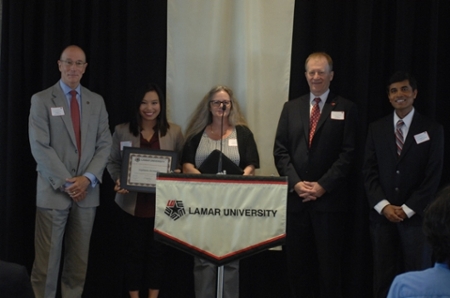
Colleges of Arts and Sciences and Fine Arts and Communication
Mentor: Dr. Edythe Kirk
Research: Extrinsic Laryngeal Muscle Activity and Heart Rate During Film Stimuli
Abstract: The startle response is a reaction to an intense stimulus, such as sudden movement or loud noise, which could be elicited by audiovisual stimuli. Neck jerking and increased heart rate are physiological reflexes that accompany the startle response. By measuring extrinsic laryngeal muscle activity and heart rate, this study aims to examine the link between expected and unexpected film stimuli on the emotional defense system. Results of prolonged hypercontraction of extrinsic laryngeal muscles as a response to stress, anxiety, or inhibited emotional expression could contribute to a spectrum of stress-related voice disorder studies.
Carlos Caballero
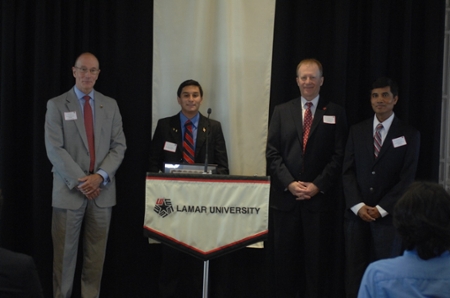
Mentor: Dr. Christian Bahrim
Research: Active Flow Control Systems and Solar Energy Harvesting Devices in Aerospace Applications
Abstract: Aerodynamic drag reduction is an essential factor in aircraft’s energy consumption efficiency. This could be achieved through local surface modulation by the use of an active flow control (AFC) system. I plan to use various materials to cover the aircraft’s wings for improving the AFC (from simple bubble wrap to optical fibers) and measure the load with sensitive force meters. Solar energy harvesting devices is a topic of great interest in the aerospace industry. I plan to use optical fibers for developing a novel AFC system at the same time with energy harvesting from solar cells.
Merideth Chilton and Nicolas Nikoloutsos
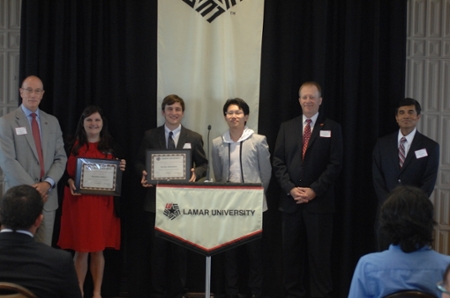
Mentor: Dr. Ian Y. Lian
Research: Exploration of a Novel Approach to Reverse Cancer Malignancy
Abstract: Malignant cancer cells are able to spread, or metastasize, by transitioning from epithelial (flat, 2D) to mesenchymal cells (spherical, 3D) and infecting a different region to form secondary tumors. Based on our research, we have demonstrated 2D-layers of multiple cancer cell lines forming 3D-structures in soft microenvironments, which is an indication of the initial and critical phase of this metastatic process. We hypothesize by transplanting the metastatic tumor spheroids back to a rigid-microenvironment, we may observe a return to the earlier 2D, less malignant morphology, suggesting a novel approach to reverse the cancer metastatic process without attempting to eradicate them.
Kyle Edwards
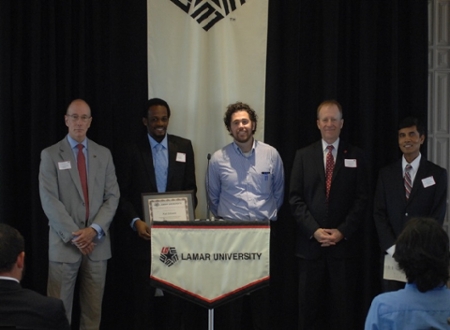
Mentor: Dr. Nicholas Brake
Research: The Development of a Cost Effective Electrically Conductive Concrete for Highway Infrastructure Applications
Abstract: The U.S. infrastructure was recently given a failing grade by ASCE and is in desperate need of rehabilitation. Smarter materials such as electrically conductive concrete have the potential to revolutionize the infrastructure through self-sensing technology and power transmission. Large-scale use of these smart materials however, is limited by their exorbitant cost ($16,000 per m3 when produced with carbon nanofibers). Research into the bulk conductivity of conductive concrete using low-cost conductive powders (copper, graphite, carbon black and magnetite) is needed. This research proposes to design an optimally proportioned, low-cost conductive concrete using these alternative powders reducing cost potentially up to 90%.
Jordan Goldstein and Chelsea McDonald
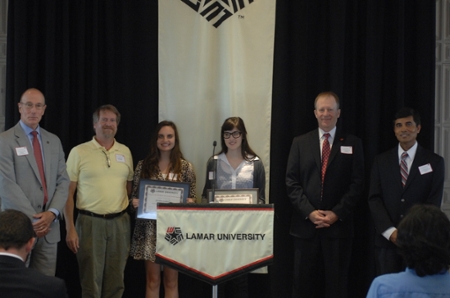
Mentor: Dr. Matthew Hoch
Research: Wind Waves Affect Benthic-Planktonic Microbial Community Interaction in Sabine Lake Estuary
Abstract: Sabine Lake is unique among estuaries of the Texas coast, but far less studied. This shallow estuary is readily affected by wind. Photosynthetic microorganisms that provide essential organic carbon to the ecosystem exist as free-floating phytoplankton and bottom-dwelling microphytobenthose. We propose that wind-wave turbulence resuspends bottom-dwelling microorganisms and nutrients into overlying waters which changes the composition of planktonic communities in the estuary. DNA analysis of plankton and bottom-dwelling microorganisms will allow detailed comparison of community compositions during calm and wind-wave conditions. Results will contribute to understanding this important, insufficiently studied estuary along with benthic-plankton interactions in shallow estuaries in general.
Omar Gonzales
Mentor: Dr. Ashwini Kucknoor
Research: The Role and Significance of Filamentous Proteopospoglycan in Leishmania Amazonensis
Abstract: Mucocutaneous leishmaniasis is debilitating human infectious disease that causes ulcers in both the skin and mucus layers and can lead to severe disfigurement of the mouth and nose. Leishmania has been successful as an infective agent partly due to its proteophosphoglycans on the surface (PPGs). Secreted PPGs are species and stage specific, and their significance in mucocutaneous forms of Leishmania have not been analyzed. The proposed study will examine the pattern of gene expression of PPGs in L. amazonensis. Real-time PCR experiments using RNA from lab-cultivated promastigotes (sandfly stage) and amastigotes (human stage) will be performed to identify the specific stage of expression. PPGs will be tagged with a reporter gene to visualize the formation of filamentous PPG during in vitro infection of human cells to establish the role of PPGs during infection and its potential as a vaccine candidate.
Christina Guerra
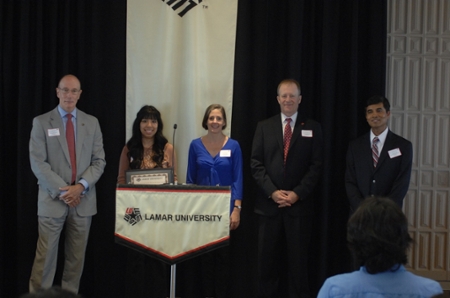
Mentor: Dr. Monica Harn
Research: Phonological Cross-Linguistic Effects in Bilingual Spanish-English Speaking Children in Early Childhood Development
Abstract: Paradis (2001) explained the Interactional Dual System Model of Language, which expresses how bilingual children can have two separate phonological systems that influence each other. Fabiano and Goldstein (2005) examined frequency and types of phonological cross-linguistic effects with bilingual Spanish-English speaking children to provide evidence regarding this theory. The children were aged 5;0, 6;2, and 7;0 (years; months). This study will provide further evidence by replicating and extending Fabiano and Goldstein (2005) with bilingual Spanish-English speaking children approximately 2, 3, and 4 years old. Speech production samples in Spanish and English will be elicited from each child during single word tasks and play activities.
Emmy Hammonds
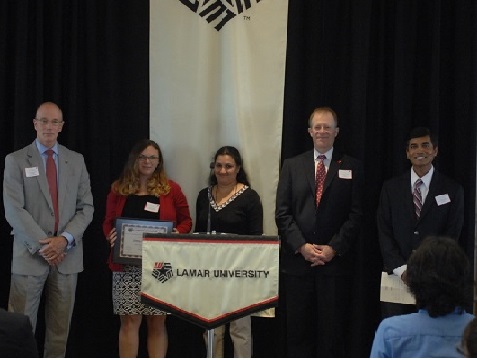
Mentor: Dr. Ashwini Kucknoor
Research: Surface Proteins of Leishmania Parasites
Abstract: Leishmaniasis is a deadly and disfiguring disease caused by the protozoan parasite, Leishmania. The goal is to identify the surface proteins of both the amastigote and promastigote life cycle stages of Leishmania, which are hypothesized to help the parasite invade its host. In order to do this, Leishmania amazonensis will be grown using Schneider’s insect medium. A SulfoLink Immobilization Kit and Coupling Resin will be used to separate the surface proteins. They will then be subjected to two-dimensional gel electrophoresis, then sent to UTMB service facility for analysis using MALDI-TOF. We will then be able to gain information on the different surface proteins present on Leishmania. This information may be valuable in creating a vaccination against the disease.
Brooke Herrin and Ashlain McGriff
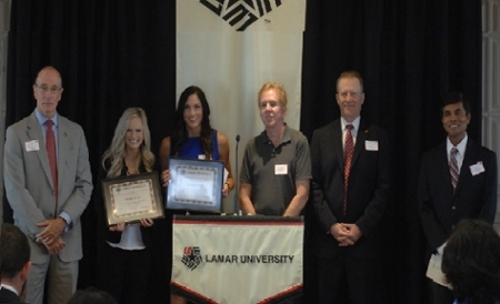
Mentor: Dr. Timothy Meline
Research: How does a History of Late Learning of Speech Sounds Affects a Child's Emotional Well-Being?
Abstract: Children with obvious differences such as speech problems are typically teased or made fun of by their peers. With speech therapy, their speech problems typically fade by the time they reach third and fourth grades. Our purpose is to discover if children with past speech disorders are emotionally impacted years after their speech problems are resolved. Interviews will be conducted to gather data about the child’s speech disorder and emotional impact. This study may reveal the existence of mental health issues related to speech problems, and will help to determine the need for emotional support and counseling for affected children.
Natalie Hudson
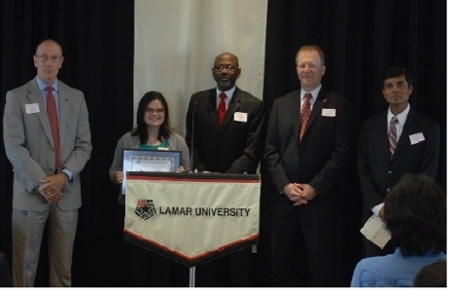
Colleges of Fine Arts and Communication and Arts and Sciences
Mentors: Dr. Freddie Titus, Dr. Robert O'Connor
Research: 3D Vector Model Teaching Apparatus
Manisha Patel
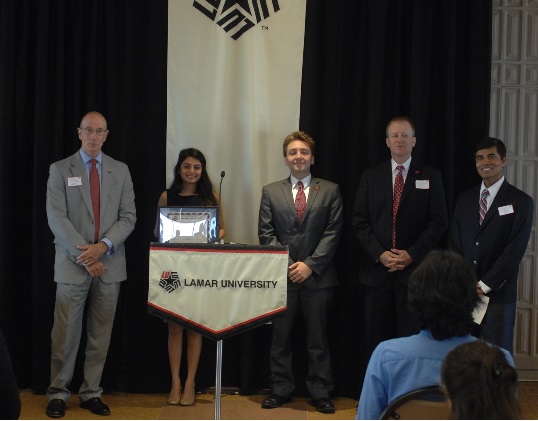
Mentor: Dr. Evan K. Wujcik
Research: Portable Device with Alumina Technology for the Filtration of Metals and Bacteria in Drinking Water
Abstract: As stated by the World Health Organization, arsenic and fluoride are two of the most
common and dangerous metals found in drinking water worldwide1. The issue arises frequently
in developing countries where water is available but is not in drinkable condition. This project
introduces a device that can not only filter out the two toxic metals and various types of bacteria,
but is also portable and light weight- allowing it to be utilized at any time anywhere when
filtered water is needed immediately. The device will consist of a small sized filter that utilizes
activated alumina technology and a bio-sand filter to create safe drinkable water.
John Pickren
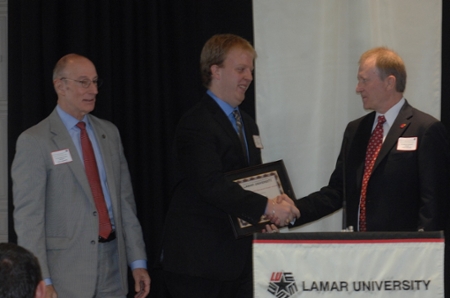
Mentor: Dr. Christian Bahrim
Research: Identification of the Chemical Composition for Over-the-Counter Medicines through Optical Analysis
Abstract: Spectroscopy allows the study of chemical composition of any material by analyzing its atomic spectrum. We will study the atomic emissions for various commonly used over-the-counter medicines and compare with ingredients listed on their pharmaceutical label. We will deposit powders or liquid medicines over a Bunsen burner flame where their atomic constituents are excited. The radiation emitted is captured by a fiber optics and guided toward a Red Tide 650USB spectrometer, which decomposes the light with a diffraction grating of high-resolution and plots the light intensity versus wavelength. From this plot we identify the composition of medicines and find the type and concentration of impurities contained. The same technique can be used to study the emission of flare towers of chemical plants and assesses the concentration of pollutants released.
Maci Reeves
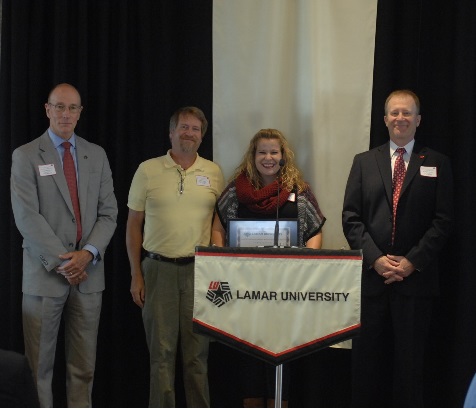
Mentor: Dr. Matthew Hoch
Research: Microphytobenthos Resuspension Results in a Priming Effect of Terrigenous Dissolved Organic Matter Mineralization in a Shallow, Well-being Estuary
Abstract: Large amounts of DOC(dissolved organic carbon) are discharged into coastal environments annually, yet only trace amounts appear in oceans. The fate of t-DOC while it transitions between systems remains a mystery. We believe Microphytobenthos resuspension results in a priming effect(PE) of terrigenous dissolved organic matter in an estuary. To test this, sediment cores will be used to simulate calm and turbulent conditions on Sabine Estuary. Plankton DNA will be analyzed for taxonomy and community composition differences. The results will lead to greater understanding of shallow estuaries and their microbial communities, and shed new light on the global carbon cycle.
Julia Richardson
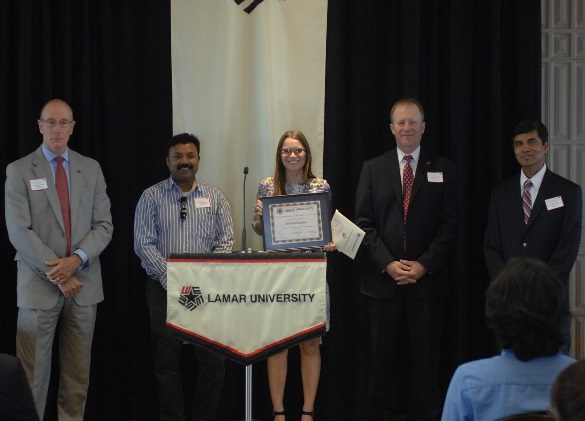
Mentor: Dr. Nadhu Radhakrishnan
Research: A Closer Look at Asymptomatic Voice Disorder & Prevention
Abstract: Voice problems or disorders are noticed by the speaker and/or the listener as difficulty in voicing or hoarseness. The prognosis in treating voice disorders depends on early identification and intervention. However, many patients see their physicians late because their voice problem does not get detected early. It is common for patients to be asymptomatic during the early stages. This study intends to show the significance of early identification. Asymptomatic subjects from the high risk group will be assessed for normalcy. The researchers hypothesize that these subjects will exhibit issues related to voice problems.
Trent Shoefstall
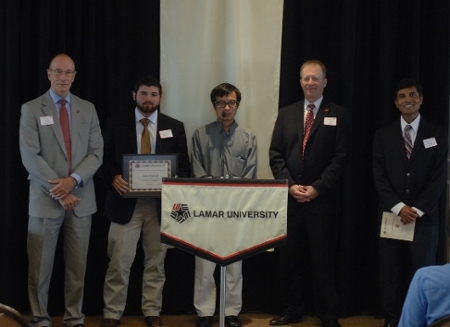
Mentor: Dr. Xuanchang Li
Research: Impact of the Length and Angles of Suction Pipes on the Performance of a Centrifugal Pump
Jamie Stafford
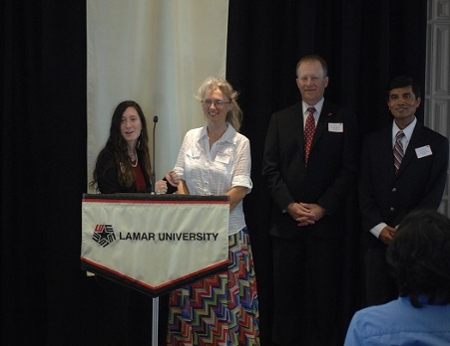
Mentor: Dr. Bogdana Bahrim
Research: Resonant Charge Transfer Processes in Ion-Surface Interactions
Abstract: The goal of this proposal is to study the charge transfer processes during H- collisions with Cu(100) and Cu(111) surfaces, by using the Wave-Packet Propagation technique. This technique is extremely powerful for ion-surface interactions, because it provides the exact solution of the dynamical problem without approximations. The projectile energy, angle of incidence with surface, distance of closest approach and surface band structure are important factors that influence the experimental ion fractions. Charge transfer studies are crucial for understanding and promoting progress in applied fields like: ion-surface collisions, plasma wall interactions, film growth, catalysis, and aeronautical and space engineering.
Kaitlin Taylor
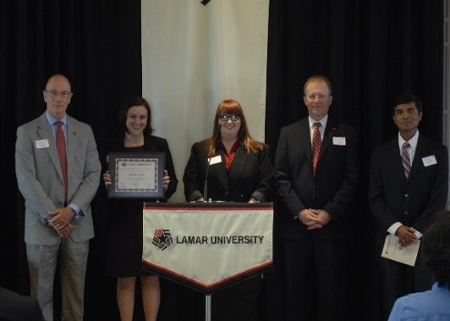
Mentor: Dr. Ashley Dockens
Research: A Survey and Analysis of Audiologist Opinion on Geriatric Audiological and Remediation Habits
Abstract: In the geriatric population, hearing loss has been associated with reduced quality of general health. My past research indicated that the geriatric hearing impaired population of Jefferson County, TX were not seeking audiological care. For the present study, certified audiology professionals across the United States will be surveyed to determine what population is seeking prevention and remediation services. Additionally, audiologists will be asked their opinion regarding potential barriers to audiological care. Data will be compiled and analyzed to further understand the current state of hearing health care for the geriatric community.
Jiaxuan Xu
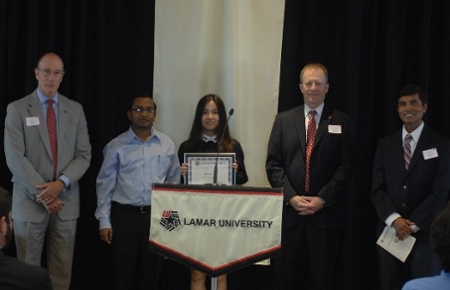
Mentor: Dr. Ramesh K. Guduru
Research: Glue-Based Thermoelectric Devices
Abstract: Thermoelectrics have widespread applications in our daily lives, but usually they are expensive. In this project, we will develop a flexible and easy to use silicone glue based thermoelectric device. Silicone glue is a good electrical and thermal insulator, and addition of an electrically conducting polymers (e.g. doped-polyaniline (PANI), poly pyrrole, and Poly 3,4-ethylenedioxythiophene (PEDOT)) to silicone while keeping its thermal conductivity low should help in developing a thermoelectric material. We expect very small additions with continuity of conducting dispersions in silicone will help achieve decent electrical conductivity while possessing poor thermal conductivity with surrounded insulating matrix.

